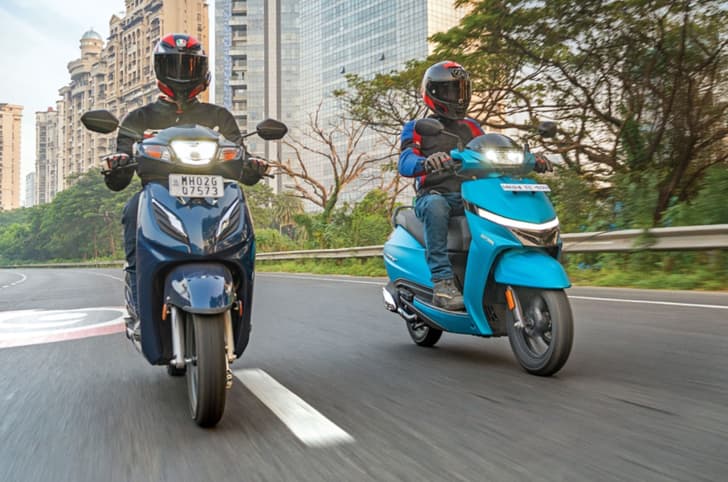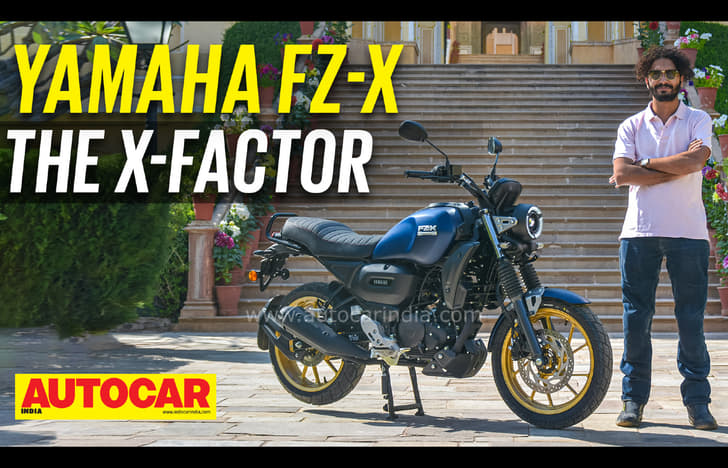Modern classic biking has never been bigger. And in India, no one does it quite as authentically—and successfully—as Royal Enfield. In the last five years, several others have tried to carve out a piece of this pie, the latest being Hero MotoCorp with its Mavrick 440. Since the Mavrick 440 uses a big air-cooled engine, it rivals two proven players in this class: Royal Enfield’s evergreen Bullet/Classic 350 and the latest Honda CB350.
Mavrick 440 vs Bullet 350 vs CB350: Design and features
In this class, appearances matter a lot more. In fact, looks are probably the biggest reason to shop in this segment. The Mavrick is the most unconventional-looking bike here, with no retro elements in its overall design. That’s not to say it isn’t good-looking, with its muscular tank and wide shrouds. The rear section, though, is quite unremarkable. Fit and finish are other areas where it lags behind the other two; switchgear and plastics could be nicer.
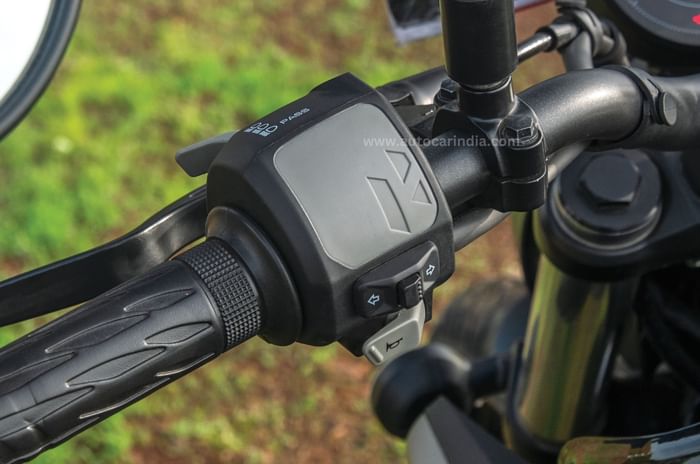
Nevertheless, the Hero has its own identity, which can’t be said for the Honda. When the H’ness came out, it had a clear Honda design identity, even harking back to the legendary CB750. But with this CB, Honda has quite closely ‘benchmarked’ the Royal Enfield Classic 350, to put it mildly. You’ll see this in the design of the large, round fenders, the long exhaust muffler, the seats’ shape, the grab handle and the front suspension shrouds. All these make it disappointingly unoriginal. In a manner typical of Honda, the quality and attention to detail are pleasing, but the heritage you see here is not Honda’s own.

And that brings us to the Royal Enfield Bullet 350, a bike whose design is the truest to its ancestor. Both the Bullet and Classic are pretty much the same bike, and we picked the former because it’s newer. The iconic headlight nacelle, chrome peashooter pipe, distinctly recognisable pilot lamps, hand-painted pinstripes and squared-off mudguard instantly identify this as the Bullet. Modern-day REs have really stepped up their quality levels, too, with the Bullet sporting the best material finish and attention to detail.
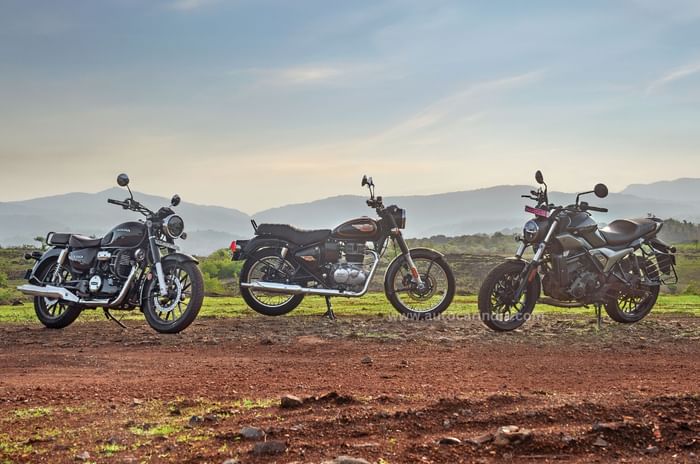
If I have to nitpick, I wish the company had given it the trademark rectangular tail-light instead of repurposing the Classic’s unit. Craftily, RE will sell you that ‘vintage tail-lamp’ as a Rs 400 accessory. It would also be nice to have metal badges rather than plastic ones.
No bike here is bristling with technology, but they’re not spartan either. When it comes to features, the Mavrick leads the way. Turn-by-turn navigation is exclusive to the Hero, and it also gets a slipper clutch and call/notification alerts.

However, as feature-rich as the Mavrick’s display is, the layout leaves much to be desired. The main information is nestled within a small digital rectangle; the rest of the space is bezel-heavy and occupied by tell-tale lights. It’s not a premium-looking display, despite the Mavrick being the most expensive among the three. The top Mavrick variant comes with a machined finish on the alloys and e-sim functionality for the dash. The mid variant doesn’t have these bits, but comes with alloy wheels. The base variant runs on wire-spoked wheels with tubed tyres and only comes in white.
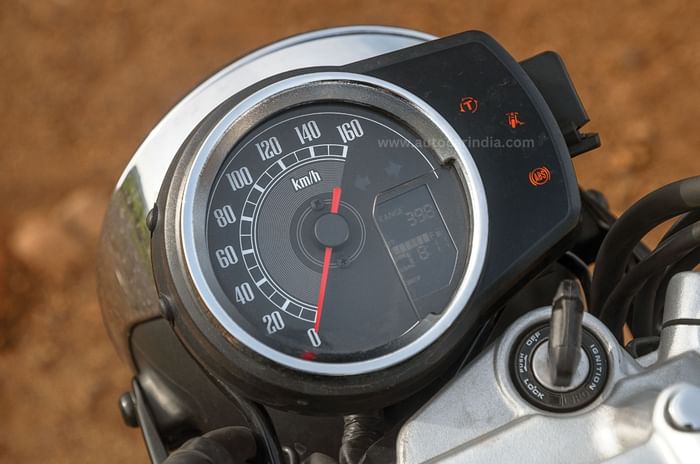
The Honda CB350 also has Bluetooth connectivity, but it only works with a headset. It also gets a slipper clutch and is the only bike here with traction control, which might seem like an overkill on a 21hp bike, but could come in handy in inclement weather.
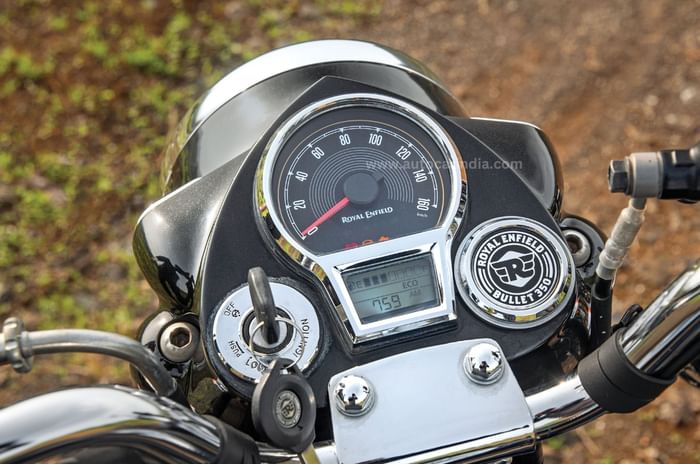
The Bullet is a relatively simple bike, even among this company. It doesn’t get a slipper clutch; the Tripper navigation pod and alloy wheels are optional extras, and its handsome digi-analogue dash doesn’t even show gear position. However, its base variant with a rear drum brake will cost you Rs 1.74 lakh, which is much more affordable—without compromising much on equipment—than the bikes we have here.
Mavrick 440 vs Bullet 350 vs CB350: Performance and handling
Just like their designs, these bikes have unique engines to suit their characters. The Mavrick’s is the biggest among the three, giving it a clear edge in performance and highway cruising ability compared to the smaller 350s. It is the only bike that has a 6-speed gearbox and can go 0–100kph in 10 seconds. This performance doesn’t really come at the expense of fuel efficiency. In our tests, the Mavrick returned 32kpl in the city and 39kpl on the highway, which is quite respectable for an engine of this size.
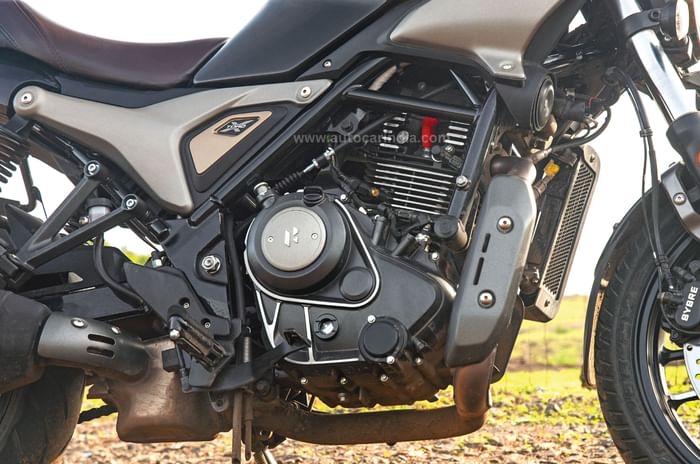
The Mavrick behaves in a considerably sportier, more communicative manner. In contrast, the other two are more laidback in nature. Its smaller 17-inch wheels make it much more agile, reminding me of the Triumph Speed 400. The Mavrick’s brakes are also the sharpest and have a good feel, too. Its exhaust note is the loudest here, with a deep, raspy tone to it.
| Acceleration | |||
|---|---|---|---|
| Kph | Hero Mavrick 440 | Honda CB350 | Royal Enfield Bullet 350 |
| 0-60 | 3.38s | 4.63s | 5.04s |
| 0-100 | 9.06s | 13.50s | 15.02s |
However, there are some drawbacks. Jerky on-off throttle transitions and strong engine braking don’t allow you to coast as peacefully as the other two. In the city, this gets tiring. Then, the added performance comes with more vibrations; anything over 4,000rpm or 100–105kph in 6th gear is uncomfortable. All this is surprising because we didn’t run into these issues on the Harley X440—a bike it is largely similar to. The scooped-out seat really hems you in place if you’re tall, and the soft padding quickly wears thin, leading to discomfort. We all unanimously agreed that this bike is the least comfortable of the bunch.

The Honda engine is the smoothest here and vibes only creep in when you’re close to the redline. It’s got an audible thump to it, though it isn’t as loud as the Hero’s. The way you’re seated on the bike is also very natural and this is an all-day comfortable motorcycle. The chassis setup is nice; while this isn’t an eager handler, it’s light on its feet and composed through corners. The suspension absorbs most jerks well, but feels a little underdamped over repeated small bumps or really big ones. Increasing the preload should help, especially with a pillion aboard.
| Roll-on acceleration | |||
|---|---|---|---|
| Kph | Hero Mavrick 440 | Honda CB350 | Royal Enfield Bullet 350 |
| 20–50 (2nd gear) | 2.34s | 3.60s | 3.65s |
| 30–70 (3rd gear) | 3.86s | 7.91s | 6.81s |
| 50–80 (4th gear) | 4.52s | 7.58s | 7.28s |
Ever since Honda’s air-cooled 350cc platform debuted, we’ve been saying that it needs shorter gearing to be able to fully enjoy it. On this latest model, too, Honda has left things exactly as they were. So, like before, you constantly need to change gears to ensure you’re in the powerband. That detracts from the otherwise relaxing riding experience. On the other hand, this tall gearing makes the CB350 a good highway cruiser that can hold 100–110kph with no buzz to speak of, but downshifts are mandatory for overtakes. It’s also the most fuel-efficient machine here. In most ways, the riding experience is similar to that of the Royal Enfield but without the effortless torque, and that’s a crucial miss. On the plus side, the CB350 has some modern niceties, such as light clutch action and tubeless tyres.
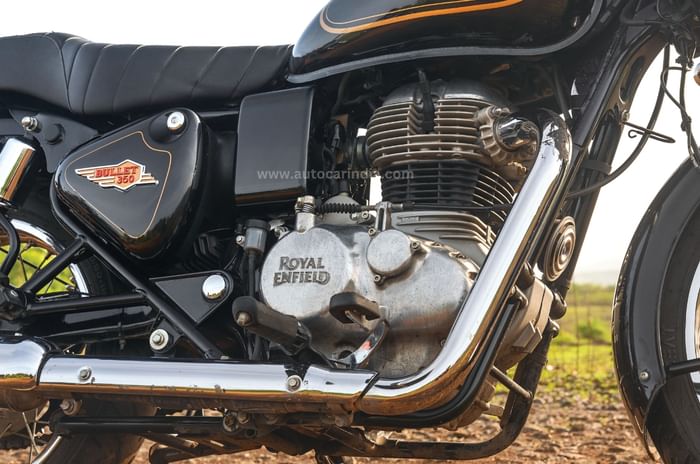
Moving on to the Bullet, it’s the heaviest, slowest and least fuel-efficient of these bikes. But all that ceases to matter once you fire up that charming 349cc motor. Its exhaust note is the most authentic of this bunch, and music to the ears.
| Braking | |||
|---|---|---|---|
| Hero Mavrick 440 | Honda CB350 | Royal Enfield Bullet 350 | |
| 60–0kph | 15.49m | 16.14m | 16.47m |
Barring the slightly taller handlebar, riding it feels almost exactly like cruising on the Classic 350. And that’s a great thing! Whether it’s the reassuringly planted feel or the way it just bulldozes (it has the best seating and suspension comfort here) almost everything the road throws at it, there’s not much to complain about. The commanding riding position makes you feel special. The engine and chassis combo transport you to such a zen state of mind that you’ll never mind riding in a mellow manner, taking in the sights. Even if you don’t want to do that and hold a steady 90–100kph, the Bullet obliges with no vibrations or harshness getting in the way.
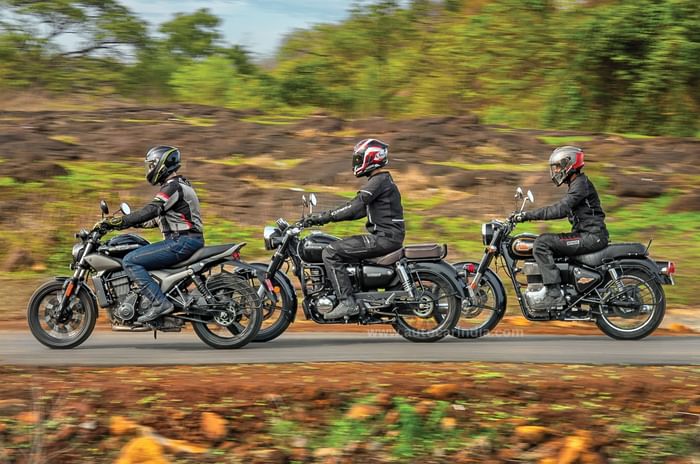
Like the Honda, the Bullet has a rather numb front brake, which doesn’t inspire much confidence when stopping quickly. If you’re a lighter or shorter person, you also need to pay attention to the 195kg kerb weight at walking speeds. It also has the heaviest clutch pull here, but that’s something you can live with.
Mavrick 440 vs Bullet 350 vs CB350: Verdict
By now, it’s clear that all the bikes here have their way of doing things. So, let’s break down what each of them is best at. Hero’s first attempt at a premium product is quite impressive. This is a rather modern bike in the way it rides. In that sense, it’s more of a Triumph Speed 400 rival. Its performance finds a middle ground between the 40hp Triumph and the 350s here. The trouble is that it is neither as happy as the other two when ridden sedately nor as comfortable on longer rides.
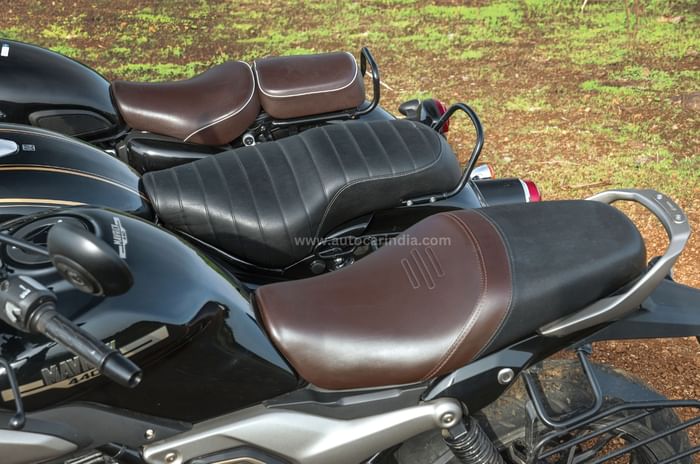
Quality levels are disappointing for what is the most expensive bike here, and in this segment at least, the Hero badge doesn’t yet match the street cred that the other two command. This is a likeable and feature-rich machine, but if you want a more authentic, retro riding experience, its Harley cousin is more befitting; however, it costs roughly Rs 50,000 more, variant for variant.
It is hard to dislike the CB350, which does so many things well and is backed up by Honda’s bulletproof reliability and low ownership costs. It’s built well, comfortable, smooth and delivers exceptional mileage.
| Fuel efficiency | |||
|---|---|---|---|
| Hero Mavrick 440 | Honda CB350 | Royal Enfield Bullet 350 | |
| City | 31.71kpl | 40.47kpl | 32kpl |
| Highway | 39.20kpl | 44.09kpl | 38.42kpl |
There’s not much objectively wrong with it, but that tall gearing really hurts it here. Where you can relax and surf the torque wave on the other two, this bike needs constant gearshifts to stay on the boil, which is at complete odds with what is supposed to be the nature of this engine.
And then there is the design philosophy. The sales numbers show that customers seem to like it, but personally, I find it hard to digest just how much ‘inspiration’ Honda has taken from the Enfields.
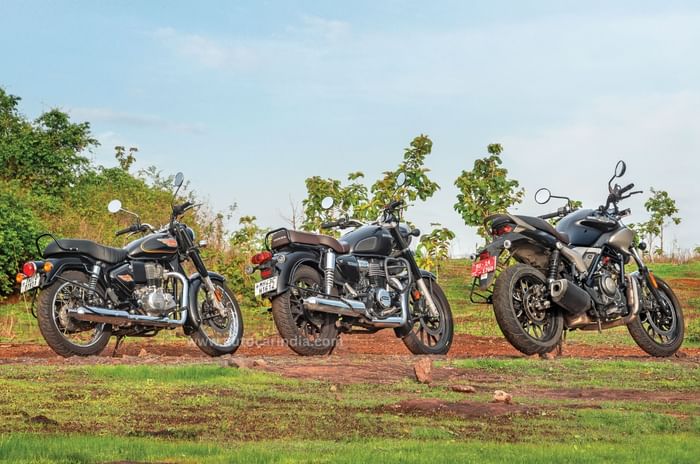
This is a segment where character and desirability play a stronger role than usual. That’s why the Bullet 350 is the winner here. It may be outclassed on the spec sheet, but when you get astride it, the numbers fade away, and you realise what a charming, well-rounded motorcycle this is.
Unlike older REs, there are no crippling vibrations, the quality is at an impressively high level, and it has the best ride comfort here. And unlike the previous-generation models, everything works just as you would expect on a modern bike.
Add to that the multiple rides and events you get access to if you’re a Royal Enfield owner, not to mention the vast dealer/service network that allows you to find spares even in remote locations. The cherry on top is that it is also the most affordable bike here, which decidedly tilts the scales in its favour.
| Specifications | |||
|---|---|---|---|
| Hero Mavrick 440 | Honda CB350 | Royal Enfield Bullet 350 | |
| Price | Rs 2.24 lakh | Rs 2.18 lakh | Rs 1.97 lakh |
| Engine | 440cc, single-cylinder, air/oil-cooled | 348cc, single-cylinder, air-cooled | 349cc, single-cylinder, air-cooled |
| Power | 27hp at 6,000rpm | 21hp at 5,500rpm | 20.2hp at 6,100rpm |
| Torque | 36Nm at 4,000rpm | 29.4Nm at 3,000rpm | 27Nm at 4,000rpm |
| Wheelbase | 1388mm | 1441mm | 1390mm |
| Kerb weight | 187kg | 187kg | 195kg |
| Seat height | 803mm | 800mm | 805mm |
| Fuel tank | 13.5 litres | 15.2 litres | 13.5 litres |
| Ground clearance | 175mm | 165mm | 170mm |
| Front suspension | Telescopic fork | Telescopic fork | Telescopic fork |
| Rear suspension | Twin shock absorbers | Twin shock absorbers | Twin shock absorbers |
| Front brake | 320mm disc | 310mm disc | 300mm disc |
| Rear brake | 240mm disc | 240mm disc | 270mm disc |
| Tyre size (front) | 110/70-17 | 100/90-19 | 100/90-19 |
| Tyre size (rear) | 150/60-17 | 130/70-17 | 120/80-18 |




